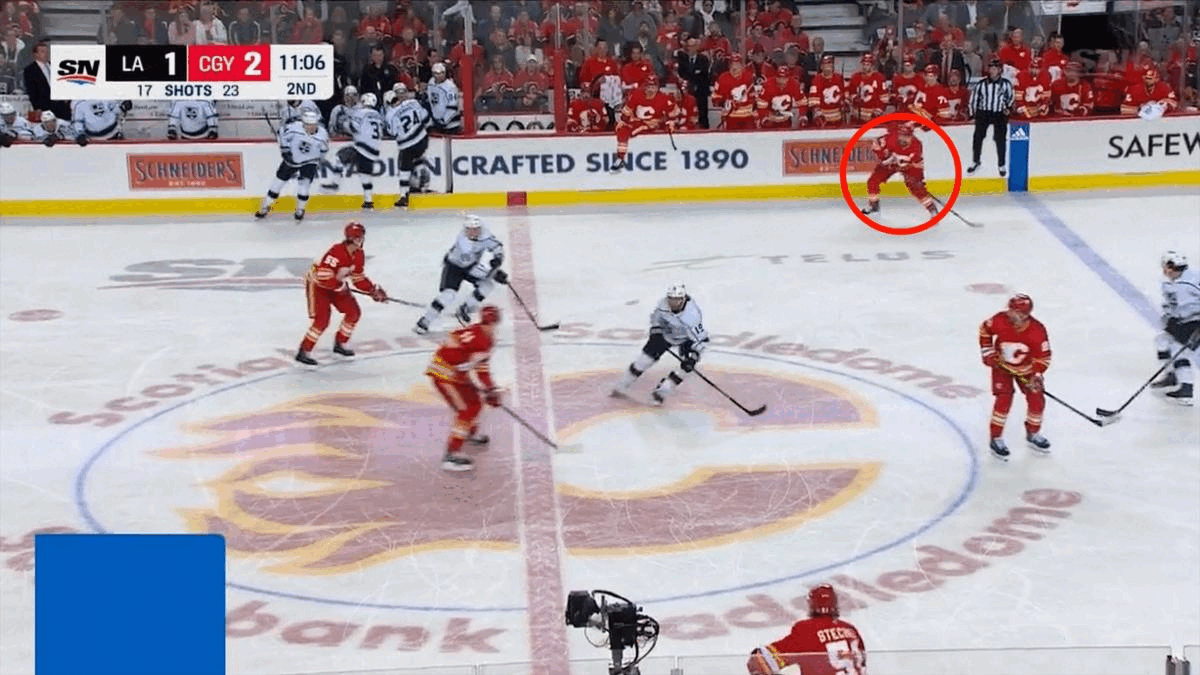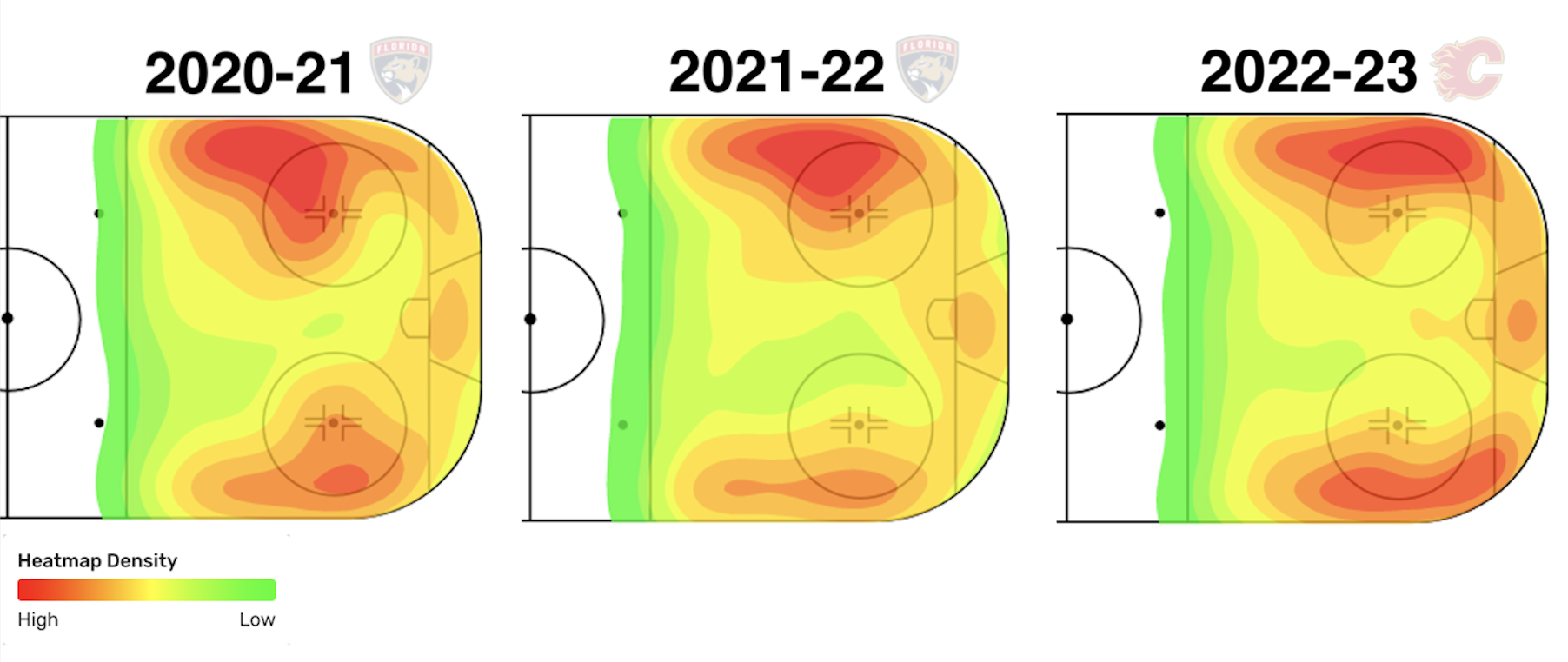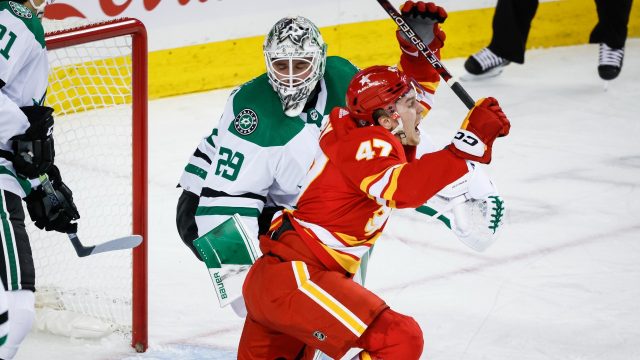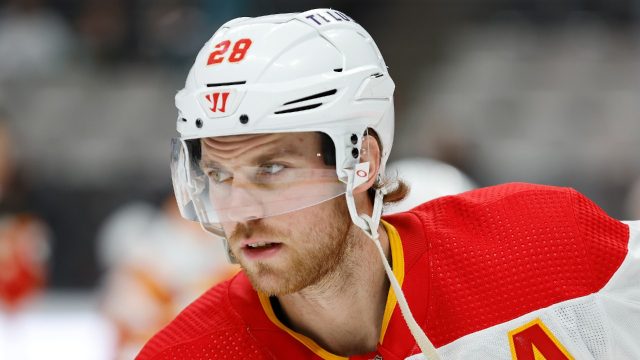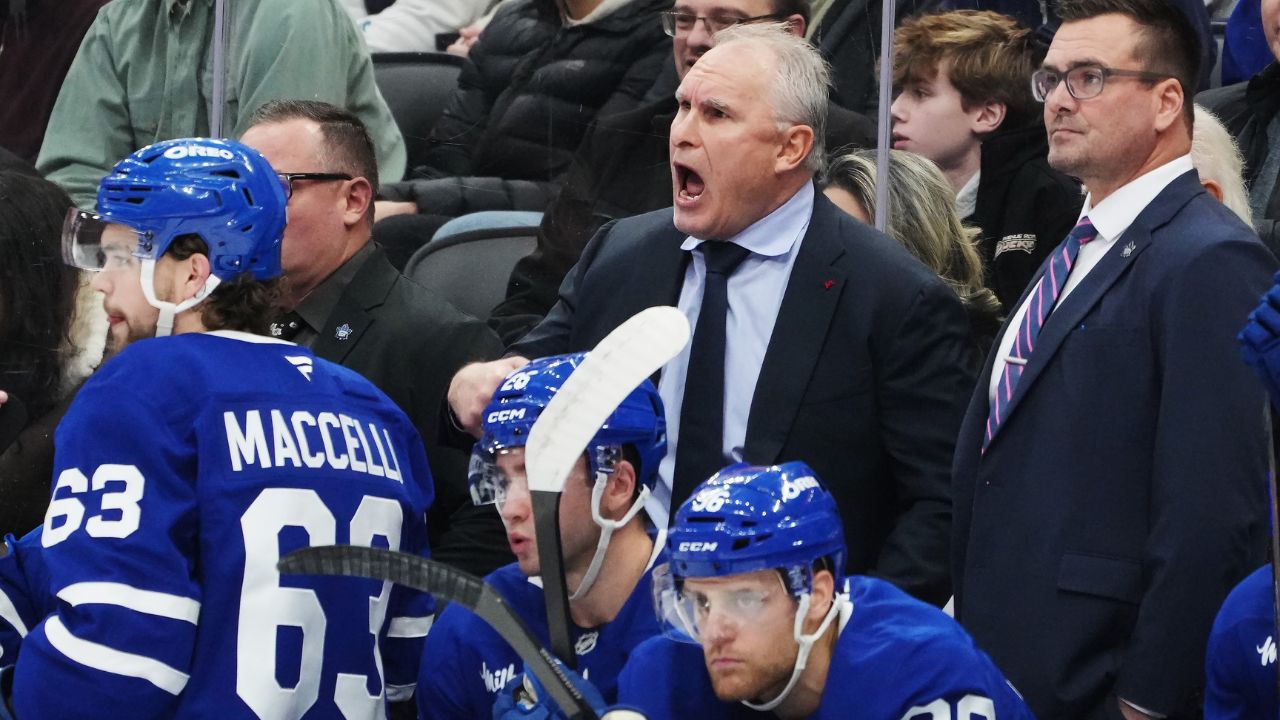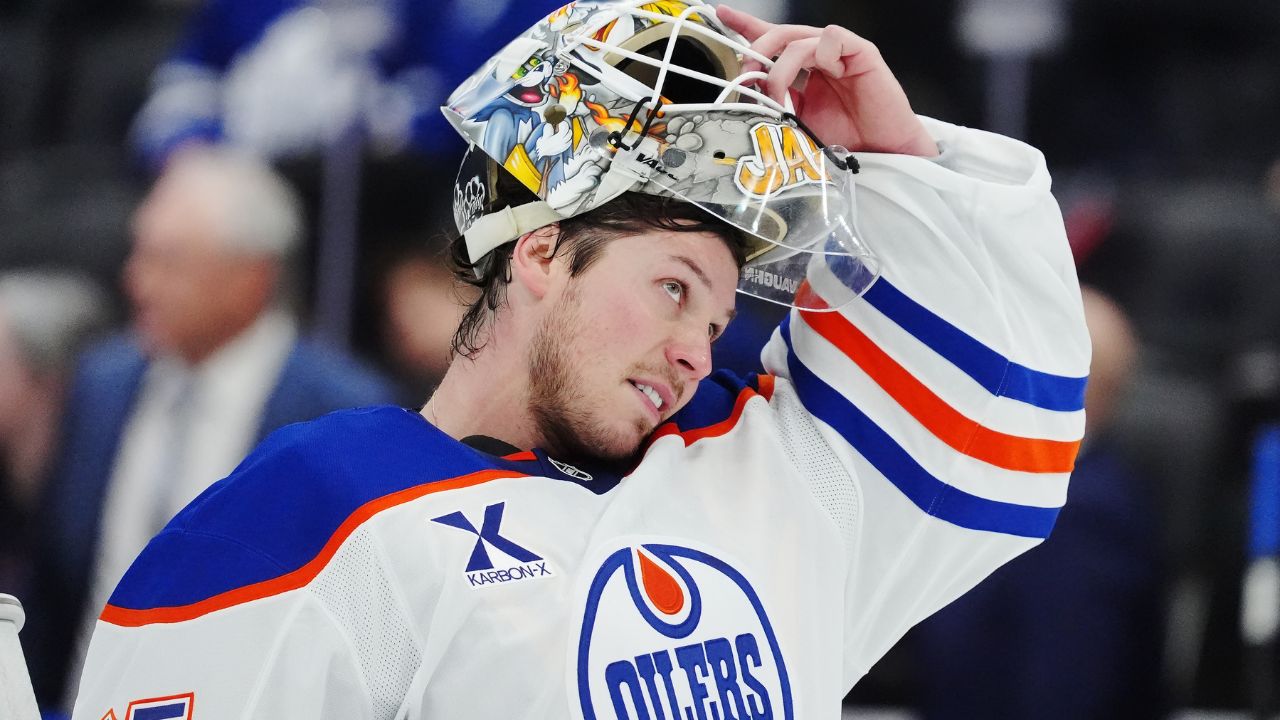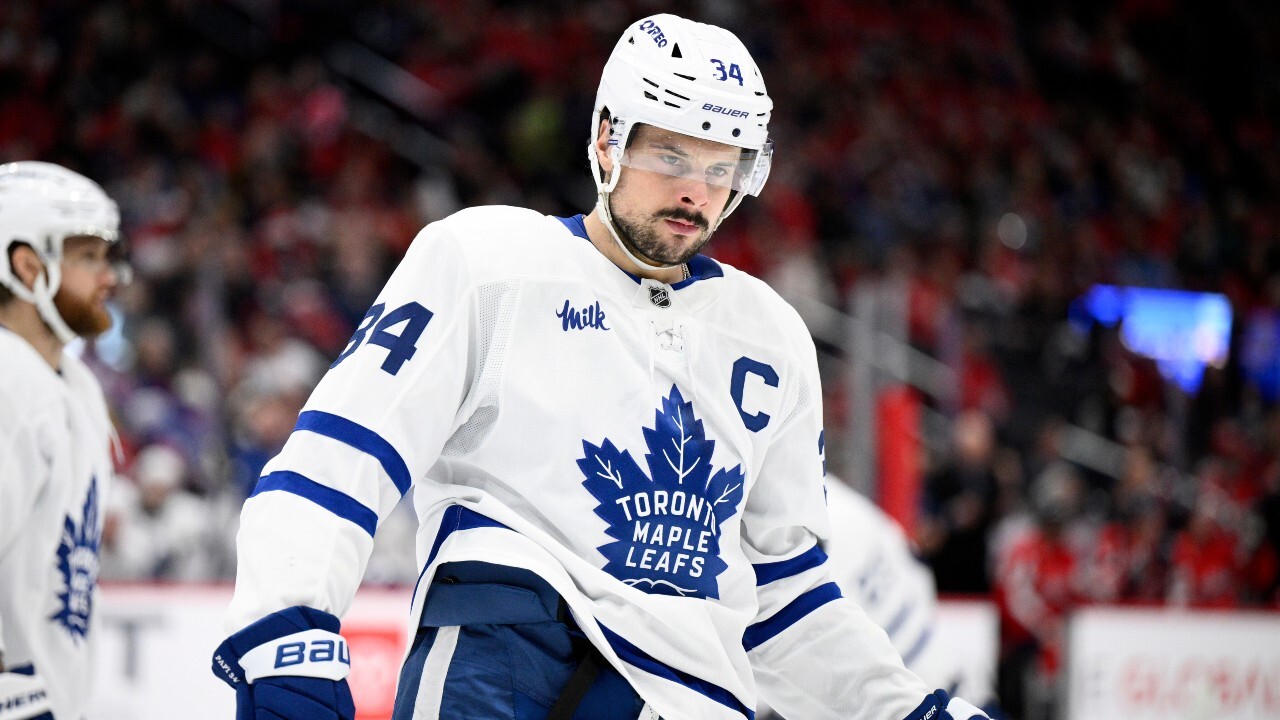
Working as a hockey scout involves constantly playing an internal game of This or That, minus the straightforward questions and having answers based simply on preference. It often entails inquiries of the following nature:
• Are aspects of this player’s performance and level of success a reflection of outcomes determined mostly by autonomy or coaching?
• Is my judgement of this player more indicative of his abilities or those of his teammates?
• Have I overestimated this player’s potential or watched him too many times?
• Have I underestimated this player’s potential or not watched him enough?
The whole thing is basically an exercise in paranoia (albeit a fun one if you like a good challenge).
The process of analyzing NHL players and especially attempting to diagnose struggles is much the same. In the case of Jonathan Huberdeau, who set a single-season league record in points by a left winger, and then registered the all-time largest drop off in production from one 60-plus game season to the next, this campaign is rife with questions awaiting answers. Chief among them are the following:
• Will a new coach with a different stylistic approach be able to maximize his talent or was Darryl Sutter’s role in the matter overblown?
• Will changes to certain systems render him more dynamic offensively or will details of his game limit his impact regardless?
• Will he find chemistry with linemates or is it not in the cards with the current roster?
While our sample size is not yet large enough to draw conclusions (though social media begs to differ), we can explore these questions further by unpacking key trends associated with last season’s pitfalls. Doing so will provide us with valuable insights into the more nuanced factors likely to influence Huberdeau’s impact, and subsequent production, this season.
We’ll focus exclusively on 5-on-5 play because the opportunity for him to be a consistent difference-maker is greatest in this context. The winger also finished top-25 in points at this strength in four consecutive seasons prior to falling outside the top 75 last campaign.
Let’s start by pinpointing the primary source of Huberdeau’s offensive struggles and we’ll dive into the underlying causes – and adjustments to keep an eye on– from there.
THE OVERARCHING ISSUE
Upon watching all of Huberdeau’s offensive zone puck touches at 5-on-5 last season (I promise I’m sane), it became clear that the bulk of his troubles could be traced back to a lack of options with possession.
This recurring theme has prevented him from leveraging his skillset and playing his game. Expecting a playmaker to create without sufficient options is like expecting a magician to perform tricks without props.
Compared to his 2021-22 season in Florida, Huberdeau has experienced a significant decline in the quantity and quality of options available, particularly off the rush and cycle – the two situations in which he’s historically generated most of his offence.
A byproduct of Calgary’s style of play and Huberdeau’s individual habits, we’ll break down the key trends specific to each situation.
Highlighting the differences in these patterns relative to the winger’s last season in Florida will help us identify the main pieces of his “success puzzle” and how they fit together.
Note: All clips of Huberdeau with the Flames are from last season to give us a basis of comparison for this season and all stats are courtesy Sportlogiq.
Up first, the rush.
TRENDS TO MONITOR OFF THE RUSH
Activation by defencemen
If Calgary’s defencemen activate more frequently and with greater urgency this season, they’ll create and preserve more options for Huberdeau.
Whether up in the play or joining it late, a defenceman involved in the rush should mean there’s a trailer who wants the puck, be it the defenceman or a forward covering for them. As someone who made a living off finding the late man in Florida, the consistent addition of this layer in Calgary has the potential to help Huberdeau immensely.
For comparison’s sake, the Flames’ back end last season was not nearly as active as Florida’s was the previous season, registering around 60 per cent as many pass attempts and scoring chances off the rush.
Here are a handful of Florida chances and goals set up by Huberdeau, courtesy of defencemen activating:
On many occasions when Huberdeau has looked to use his defencemen in Calgary, they’ve either not been there or haven’t positioned themselves as quality options. Gliding into the play rather than hustling to space (see squiggly arrows in the ensuing clips), drifting to the outside rather than driving up the middle, and having their sticks in the air rather than on the ice are good indications of the latter.
As you’ll see in these examples, this lack of engagement results in Huberdeau looking elsewhere or making a harmless play to the top of the zone.
Since a lack of involvement from blueliners limits the number of offensive threats that exist, the puck carrier loses leverage. The fewer moving parts that are in a given situation, the easier it is for the opposition to identify and prepare to neutralize these options, if not eliminate them altogether.
By activating, a defenceman has the power to shift the balance in the puck carrier’s favour not only via offering an additional option, but also preserving others. Garnering attention and creating confusion, this player has the capacity to manipulate coverage in a way that leaves teammates unmarked or covered poorly, or buys the puck carrier extra time and space.
The first two clips below are examples of the former, highlighting how offensively impactful Florida’s defencemen were even when they didn’t touch the puck. The next two clips illustrate the contrast in Calgary, with defencemen opting to basically exit stage left amid opportunities to provide the puck carrier more to work with by simply acting as a decoy.
In order for a trailer or decoy to be effective, everyone on the ice needs to work together to create favourable conditions for the puck carrier, which leads us to…
Off-puck support
If Calgary’s skaters prioritize improving the passing conditions they produce, they’ll provide Huberdeau with more viable options.
This point is comprised of a whack of variables pertaining to angles, lanes, movement, and spacing, but we’ll walk through two particular patterns that capture the essence of the matter.
The first takes us back to grade four math class.
When teammates are situated at angles that are overly acute relative to the puck, a defender can cover the passing lanes to each of them at the same time. In other words, instead of having two or three options, the player with possession has one, if you want to even call it that.
Tasked with threading the puck through one if not several defenders, delivering a successful pass cleanly becomes a challenge, no matter how talented the passer. Huberdeau is no exception.
The Flames’ geometry woes are a function of teammates neglecting to read off one another and alter their routes accordingly.
While the MO of the Presidents’ Trophy-winning Panthers was finding space off the puck with curved routes, east-west cuts, and delays or changes in speed, the Flames prefer to establish close proximity to the net and like to head straight north off the rush.
Doing so often involves skating into traffic and closing the gap between oneself and a defender. The space where a pass can hypothetically be received therefore shrinks, as does the window of time the lane remains available.
When more than one player exercises this route at the same time (or the other players in the picture fail to offer convenient support), the puck carrier is left with… well, not a whole lot.
Here are examples of both configurations at play:
And here are examples of the quality of support Huberdeau was used to in Florida:
When you consider this discrepancy, Huberdeau’s turnovers and less-than-ideal plays as a Flame become easier to understand. This quote from the 30-year-old back in February sums up the issue well:
“My strength is, I see the play. But if the play doesn’t develop like I want it to, then I get stuck, and then I make a play that I don’t want to do, and then I look like [garbage].”
Speaking of how plays develop, the way sequences begin is also an important factor.
Puck advancement
If the Flames move the puck up-ice quicker, they’ll manufacture situations with more possibilities for Huberdeau.
When a pass that covers substantial ground is made without hesitation, it can lead to numerical advantages and trigger staggered layers (trailers and favourable angles) as teammates join the play in waves. Catching the other team out of their defensive structure typically produces all sorts of breakdowns that allow players to slip through the cracks as well.
Calgary has tended to rely on a series of shorter passes or carries to move the puck north, so these benefits are harder to come by.
If you re-watch the clips we’ve reviewed thus far, many of them will give you a sense of how drastically the Panthers differed from the Flames in this area. Notice the contrast in the amount of offensive zone congestion Huberdeau encounters and the opposition’s panic level.
From a statistical standpoint, Calgary attempted 231 fewer stretch passes last season than Florida the season prior – a differential that separated the 27th-ranked Flames from the ninth-ranked team last campaign.
Since he was promoted, Flames bench boss Ryan Huska has made a point of emphasizing that he wants his team to play faster, especially in transition. If this desire translates, it’ll be good news for No. 10, who also needs to add some speed to his game. Enter…
Huberdeau’s feet
We’ve dug into how external factors have hindered Huberdeau’s offensive impact, but what can he do to set himself up for greater success?
The simplest way he can shift the complexion of his rush possessions is by moving his feet more prior to the puck’s arrival.
When Huberdeau receives pucks with little to no momentum (spoiler alert: it happens a lot), his options are limited even further.
Since acceleration isn’t a strength of his, these circumstances negate his ability to be a threat on his own, thwarting him from attacking space, driving wide, cutting to the middle, or challenging a defender 1-on-1.
Simply put, he becomes one-dimensional and is left relying on teammates to enable his next play.
Huberdeau didn’t find himself in these positions as often with Florida because the team’s system inspired constant movement. And even when he did, a successful play usually followed thanks to the other factors we’ve already outlined.
As inconsequential as this matter may have previously been, it’s proven costly in Calgary with forced passes and low-percentage plays.
Circling back to the two systems for a minute, the Flames’ wingers are not put in spots where maintaining momentum comes easy, contrary to what Huberdeau experienced with the Panthers.
Last season, Calgary’s breakout was predicated on at least one winger flying the zone early, while both typically stayed high on neutral zone regroups, hovering around the offensive blue line. Those tactics still appear to be in play under Huska and tend to force the wingers to stop or slow down to stay onside (especially when the puck isn’t advanced quickly) since they’re usually ahead of the action.
Regardless, Huberdeau too often waits for pucks to come to him rather than proactively moving his feet.
No matter where he’s situated on the ice, developing a habit of exercising various reload routes will allow him to catch pucks in acceleration versus while trying to accelerate.
This adjustment primes him to operate with speed, which would unlock more options and the confidence to entertain them. As he becomes more dynamic, he’ll feel less of a need to defer to teammates and his internal “get rid of puck” alarm won’t sound as easily.
Plus, Huberdeau’s capacity to pull defenders out of position and manipulate coverage will increase, translating to more openings and offence.
Below are three examples from last season of the kind of smart reload routes Huberdeau needs to use more.
The first is a lateral cut across the offensive blue line (note how he’s above the puck to start this sequence), which equips him to take advantage of the space he’s afforded and skate into a dangerous spot for a shot.
The second is a low swing, enabling him to charge off the wall for a middle entry. This assertive move creates an easy puck recovery for a teammate and culminates in a goal.
The third is a curl back, which sets him up to skate on to the puck and challenge a defender with speed. A threat to drive wide, he frees up the dot lane for a teammate who walks in and scores.
TRENDS TO MONITOR OFF THE CYCLE
High vs. low possessions
If Calgary works the high cycle more this season, Huberdeau will find himself in offensively advantageous positions more often.
The main benefits of playing higher in the offensive zone as a forward are threefold:
1. More favourable matchups and less physicality.
Since blueliners tend to avoid straying too far from their net, forwards – who generally aren’t as adept at eliminating options with their body positioning and stick detail – will likely be defending you instead.
Teams also tend to assume a less aggressive approach when pressuring up high versus down low. Defenders don’t close as quickly or play the body as heavily.
2. More time and space.
3. Wider field of vision.
It’s easier to survey everyone’s whereabouts and identify movement patterns when you’re stationed above most of the action and are looking down at the net.
In one way or another, all three points add options and feed into Huberdeau’s brand of hockey, which rests on leveraging his vision and minimizing contact.
That said, the low cycle took precedence in Calgary last season. Unlike in his two seasons prior in Florida, the majority of Huberdeau’s puck touches transpired below the dots rather than above them:
The shift in the darker red blobs tells us that the forward was handling more pucks in spots he wasn’t as used to or comfortable with. The decrease in red/orange between the dots suggests he also played more on the perimeter.
As you may expect, these differences saw Huberdeau’s possession and puck protection numbers drop:
Adapting to a change in geography is one thing, but as we’ll discover in this next section, trying to do so without much help is another.
Off-puck support (the sequel!)
As we’ve laid out, if the Flames’ skaters do a better job of making themselves available, Huberdeau will have an easier time successfully making plays and creating chances.
Availability in the context of a cycle is comprised of two key components: proximity and movement.
When teammates, and more specifically forwards, stay relatively close to one another, passes are less likely to be disrupted as the puck has a shorter distance to travel. This principle holds especially true when attempting to make passes to the slot.
Calgary’s group plays more spread out, which explains in large part why the team finished with the fourth-worst slot pass success rate in the league last season.
Players were also easy to track and passes easy to anticipate in general due to a lack of individual and collective movement. The Flames were too often waiting for pucks to find them through coverage or were slow to move to better spots. There wasn’t enough simultaneous movement involving multiple players, either.
When asked over the summer about generating higher-quality chances, Huska referenced the need for his defencemen to be more active in order to make coverage tougher for the opposition.
See video evidence of these distance and movement issues, which left Huberdeau on an island at times:
And a look at the remarkable difference on both fronts with the Panthers (you could teach a masterclass on puck support using only the first clip):
Here’s where we can make more sense of our subject’s troubles finding chemistry with linemates.
As the Florida plays demonstrate, Huberdeau’s expertise lies in recognizing opportunities to isolate defenders in small spaces and create mini 2-on-1s.
It’s his offensive blueprint and it worked brilliantly with the Panthers. A teammate gives him the puck, jumps to beat their check to space, and receives the puck back in a grade-A spot.
Both parties work smarter rather than harder.
The problem, of course, is that Huberdeau’s yet to find someone on the Flames who operates with the same blueprint. It oftentimes seems like he’s thinking one thing while his teammate is thinking another, and the play doesn’t develop the way either one had hoped.
As a result of this incompatibility, Huberdeau hasn’t been able to play to his strengths.
Though he can’t control his teammates, he can focus on finding ways to generate more offence on his own. The starting point?
Huberdeau’s feet (again!)
As you’ll notice in the Calgary clips, No. 10’s teammates weren’t the only ones moving in moderation.
In order to create his own “outs,” and become more comfortable holding on to and protecting the puck, Huberdeau needs to work on moving his feet sooner (aka as the puck is approaching) and keep them moving with possession.
This adjustment will allow him to get up the wall and especially off the wall to attack space, both of which will render him more dangerous.
These movement patterns are also more likely to cause confusion and defensive breakdowns.
From a 1-on-1 standpoint, this detail has the potential to minimize the frequency with which Huberdeau is knocked off the puck or squeezed out along the boards.
By moving earlier after inviting contact, he’ll be able to establish body position on defenders. And, by moving off the wall, he’ll be able to create pockets of space that he can cut back into and use as an escape route to elude pressure.
Once again, I present you with three examples from last season of the proactive movement and attack mentality we want Huberdeau to exercise on a more consistent basis.
In the first, he establishes inside position on an opponent by sprinting out of the corner en route to finessing his way into the slot for a shot attempt.
In the second, he picks up the puck mid-crossover and charges to prime ice without hesitation for a wrister.
In the third, he explodes off the wall while catching the puck, freeing up the slot for a teammate to score uncontested.
CONCLUSION
Phew, we made it.
This one is tough to put a bow on, but I’ll leave you with a few parting thoughts.
Like many situations in life, Huberdeau’s struggles in Calgary are not black and white. They’re a whole shade of complicated and none of the variables we discussed exist in isolation. They’re all interconnected and a change in any one independently won’t serve as a magic fix, though it may trigger a domino effect of positive shifts in general. Small shifts can collectively make a big difference.
Obviously, this list of factors isn’t exhaustive either (those perpetually screaming at their screens for No. 10 to shoot will be the first to agree). Somewhere in this mix is the human factor, too. This deep dive does, however, paint us a fairly comprehensive picture of some underlying trends that are steering the ship.
And finally, Huberdeau is a very good hockey player. Registering over a point a game in four straight seasons doesn’t happen by accident. While he’s not a guy who’s going to drive play singlehandedly or skate laps around the other team à la Johnny Gaudreau, he can glue plays together in a way not many others can.
In an environment conducive to movement and strong support, and with teammates who are on the same wavelength and understand how to effectively leverage his skillset, Huberdeau is a difference-maker in this league.
With a little bit of This and a little bit of That, it’s still possible he can be that guy for the Flames.
Vanessa worked as a scout for the USHL’s Chicago Steel for three seasons and was a video analyst for TMU’s women’s hockey team.



